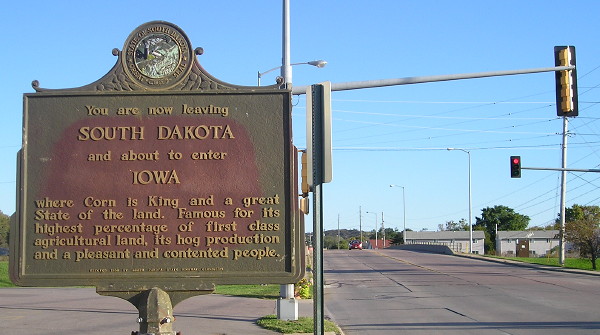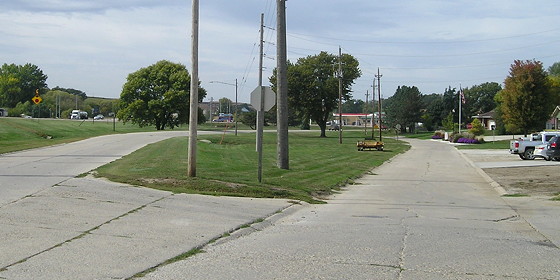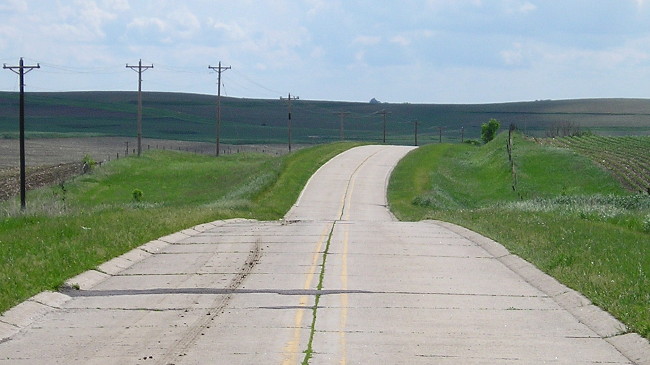
(July 1, 1920-October 16, 1926)
- In 1920, they knew it as: The Hawkeye Cutoff, registered September 25, 1916, or Hawkeye Short Cut, a way to get from Sioux City to Fort Dodge without going through Cherokee (5 counties)
- We know it as: The pre-four-lane US 20 corridor between those two cities
- Let's get granular:
- Sioux City: Military Road, Ross Street, W 7th Street, Pearl Street, 4th Street, vanished connection to Westcott Street, 2nd Street/Fairmount Street (EB) and 1st St (WB), Fairmount Street, Correctionville Road, Logan Street, the north side of the parking lot of the Gordon Drive Hy-Vee, Green Avenue, Correctionville Road
- There's still a garage/auto shop at the corner of Military and Ross.
- The connection between 4th and Westcott was erased by the channelization of the Floyd River and the Floyd Boulevard that carries Business 75 — except for a bridge that now goes over dry land.
- Woodbury County: Dallas Avenue, 150th Street, Garner Avenue, US 20, IA 140, Main Street (Moville), 150th Street, Ida Avenue, 160th Street (not Wood Trail) with a harder corner at/east of L25 intersection, D22, Michigan Avenue, 155th Street, D22, vacated road that dipped south of the present 160th Street/IA 31 intersection and east nearer the Little Sioux River, vacated road that crossed the Little Sioux just upstream of present, IA 31, D22, Driftwood/5th/Knotty Pine streets in Correctionville, vacated road from the end of Knotty Pine (now a driveway) east to Oscar Avenue, vacated road on northeast side of D22 that runs into driveway to Pocahontas Avenue, D22
- Look for how it passes by or very near a lot of cemeteries between Sioux City and Schaller: On Correctionville Road just east of Charles Avenue, halfway down K49 to Lawton, just south on L21 at the extinct map dot of Rock Branch, on the east side of Correctionville, west of Cushing, the corner of Jasper Avenue and D15, the east side of Galva, and northwest of Schaller.
- A noticeable curve in the late 1930s aerial photos between Knotty Pine and 3rd streets may mean the route on the east side of Correctionville (past the intersection of 5th and Fir at the school) was slightly different than described here.
- The not-D22 parts east of Moville that I have attempted to describe were left behind in 1924; see news excerpt down the page
- Cushing to Early: L51, 150th Street (and continuation east of Indian Avenue)*, Jasper Avenue, D15, 2nd Street and a block of 1st Street in Schaller, IA 110, 210th Street, Fox Avenue, US 20 (0.2 mile), M43, 230th Street
- *The state maps look like 23 used US 59 and D15 (straight west of Galva), while the 1912 Huebinger map and 1914 Ida County map shows it going straight through Holstein on 2nd Street then 150th to Jasper, a mile south of that route.
- Huebinger's 1912 map also keeps the route on 210th Street east to present US 71; that was ditched not long after to avoid two crossings of the C&NW between Schaller and Early.
- Early to Moorland: IA 471, then D36 except where it followed:
- Park Avenue on the east side of Sac City
- N28 and 270th Street (the Lytton diagonal was part of paving in 1938)
- Maybe 8th Street, Main Street, and 1st Street in Rockwell City? It seems logical but I have no evidence.
- High Street across the railroad tracks and Lake Creek, including the abandoned 1915 Marsh Rainbow Arch Bridge that was bypassed in 1933 (not 1981, as this Iowa DOT page says; that is the year the county closed it)
- Zearing Avenue, 250th, P33, and Western/Main/2nd streets in Moorland
- Moorland to Fort Dodge: Grand Avenue and George Avenue (the same road, broken by new US 20) and D20, but replaced with 240th Street and Hayes Avenue in 1921; 230th Street; P51 with un-rounded corner at Johnson Avenue/255th Street; Theater Road and slight extension northward; US 169
- Fort Dodge: A Street, Avenue G, C Street, Avenue D, D Street, Avenue C, Bennett Viaduct (gone), 3rd Street
- Point of interest: A significant portion of the original route between Early and Moorland remained in the state system as US 20 until the completion of the four-lane in 2012 and 2015. Now all that's left, give or take a shift of a few hundred feet, are:
- US 20 (westbound lanes) between Garner Avenue and IA 140 (1 mile)
- IA 140 in Moville (about ½ mile)
- IA 31 across the Little Sioux River to the Aspen Street post-2015 route on the west side of Correctionville (a new bridge was built next to the old one in the 1990s) (0.6 mile)
- IA 110 from 1st Street in Schaller to 210th Street (0.7 mile)
- US 20 at the section line offset for Fox Avenue (moved off the exact line with four-laning)
- IA 471, formerly US 71, from South Street in Early to D36 (2½ miles)
- IA 4, the one-mile east-west jog with D36/old 20 (1 mile)
- US 169, a mix of NB and SB lanes past Frontier Village (0.7 mile)
- See also: Sioux City Highway Chronology, Fort Dodge Highway Chronology
WEST End: South Dakota state line (Big Sioux River), Sioux City IA/North Sioux City SD, Woodbury County IA/Union County SD

Facing southeast, from South Dakota (9/30/15)
Although it seems like it would have made more sense for IA 23 to head
into Nebraska on the Combination Bridge, the 1925 and 1926 state maps'
Sioux City inset clearly mark IA 23 through northwest Sioux City. The
name Military Road and its winding nature tell us it's one of the
original paths in the area. More pictures are at the Historic
Iowa termini of US 77 page.
Along the route
Why does this road exist? As in, why wasn't there a straight-line number across the state where US 20 is today? Because inertia is a powerful thing. By the time of the creation of the 1920 system, the Hawkeye Highway had been around for a decade, and it was intended to follow the Illinois Central Railroad, which meant going through Cherokee and Le Mars and not Rockwell City and Sac City. The Hawkeye became the U.S. Grant Highway in 1919, for the president who once lived in Galena, Illinois, and that honorary designation eventually passed to US 20.

Frontage road in Moville, facing west (10/2/20)
Here you can see original 1924 concrete on the right, and a 1940s line on the left. The first concrete crossed the West Fork Little Sioux River in a diagonal direction. The offset was removed when the US 20/IA 140 intersection was rebuilt (the later pavement) before 1949 (with the riverbed moved), and then present 20 was built in 1957.
A century after creation of IA 23, the four-way stop at IA 140 is the only place a traveler must come to a stop between Sioux City and Dubuque.
Summer
floods take unusually heavy toll of Iowa bridges — approximately 80
destroyed
Iowa bridge builders meanwhile have had a fairly busy year on street and
railroad crossing structures. There have not been many bridges of
standing size, but there have been a large number of splendid structures
erected at important points on the primary road system. The most
important of these bridges probably was the concrete structure at
Correctionville over the Little Sioux River which took the place of an
old steel truss which was in a particularly dangerous condition for this
important highway. The old structure was in such a condition that the
contractor had to repair it before transporting his materials and
equipment to the opposite side in order to begin operations on the new
bridge. The new bridge and relocation eliminates dangerous and difficult
bends in the approaches and involved an extreme channel change.
— Iowa Highway Commission Service
Bulletin, July-Aug-Sep 1924
[The relocation in question runs on present D22. -Ed.]

Facing west (6/4/14)
The entire route of IA 23 in Woodbury County was paved by the end of 1924. This segment east of Cushing, in Ida County, did not become part of the route until then, was paved in 1932, and remained part of US 20 until 1958. At the time this picture was taken, the concrete was 82 years old but had only three years to live. The segment east of L51, although mostly in good condition for concrete of its age, was removed at the same time present US 20 to the north was four-laned.
EAST End: IA 5, now 3rd St. at Central Ave., Fort Dodge, Webster County
IA 23 had an overlap with IA 16/90 until the latter moved to River Road in 1922. All three routes crossed the Des Moines River on the Bennett Viaduct, which lasted until 1981 and left a pier in the middle. As late as the late 1970s the area between Meriwether Drive and the river was full of houses. The viaduct went all the way to the intersection of 2nd Avenue and 3rd Street. Two blocks north, 16/23/90 met the Hawkeye Highway, but the designations might have ended at the Webster County Courthouse at the intersection of Central Avenue and 7th Street.
Page created 4/27/20; last updated 5/7/22